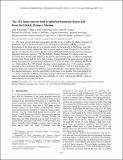| dc.contributor.author | Konopliv, Alex S. | |
| dc.contributor.author | Park, Ryan S. | |
| dc.contributor.author | Yuan, Dah-Ning | |
| dc.contributor.author | Asmar, Sami W. | |
| dc.contributor.author | Watkins, Michael M. | |
| dc.contributor.author | Williams, James G. | |
| dc.contributor.author | Fahnestock, Eugene | |
| dc.contributor.author | Kruizinga, Gerhard | |
| dc.contributor.author | Paik, Meegyeong | |
| dc.contributor.author | Strekalov, Dmitry | |
| dc.contributor.author | Harvey, Nate | |
| dc.contributor.author | Smith, David Edmund | |
| dc.contributor.author | Zuber, Maria | |
| dc.date.accessioned | 2014-03-20T20:39:48Z | |
| dc.date.available | 2014-03-20T20:39:48Z | |
| dc.date.issued | 2013-07 | |
| dc.date.submitted | 2013-05 | |
| dc.identifier.issn | 21699097 | |
| dc.identifier.uri | http://hdl.handle.net/1721.1/85858 | |
| dc.description.abstract | The lunar gravity field and topography provide a way to probe the interior structure of the Moon. Prior to the Gravity Recovery and Interior Laboratory (GRAIL) mission, knowledge of the lunar gravity was limited mostly to the nearside of the Moon, since the farside was not directly observable from missions such as Lunar Prospector. The farside gravity was directly observed for the first time with the SELENE mission, but was limited to spherical harmonic degree n ≤ 70. The GRAIL Primary Mission, for which results are presented here, dramatically improves the gravity spectrum by up to ~4 orders of magnitude for the entire Moon and for more than 5 orders-of-magnitude over some spectral ranges by using interspacecraft measurements with near 0.03 μm/s accuracy. The resulting GL0660B (n = 660) solution has 98% global coherence with topography to n = 330, and has variable regional surface resolution between n = 371 (14.6 km) and n = 583 (9.3 km) because the gravity data were collected at different spacecraft altitudes. The GRAIL data also improve low-degree harmonics, and the uncertainty in the lunar Love number has been reduced by ~5× to k2 = 0.02405 ± 0.00018. The reprocessing of the Lunar Prospector data indicates ~3× improved orbit uncertainty for the lower altitudes to ~10 m, whereas the GRAIL orbits are determined to an accuracy of 20 cm. | en_US |
| dc.description.sponsorship | United States. National Aeronautics and Space Administration | en_US |
| dc.language.iso | en_US | |
| dc.publisher | American Geophysical Union | en_US |
| dc.relation.isversionof | http://dx.doi.org/10.1002/jgre.20097 | en_US |
| dc.rights | Article is made available in accordance with the publisher's policy and may be subject to US copyright law. Please refer to the publisher's site for terms of use. | en_US |
| dc.source | MIT web domain | en_US |
| dc.title | The JPL lunar gravity field to spherical harmonic degree 660 from the GRAIL Primary Mission | en_US |
| dc.type | Article | en_US |
| dc.identifier.citation | Konopliv, Alex S., Ryan S. Park, Dah-Ning Yuan, Sami W. Asmar, Michael M. Watkins, James G. Williams, Eugene Fahnestock, et al. “The JPL Lunar Gravity Field to Spherical Harmonic Degree 660 from the GRAIL Primary Mission.” Journal of Geophysical Research: Planets 118, no. 7 (July 2013): 1415–1434. | en_US |
| dc.contributor.department | Massachusetts Institute of Technology. Department of Earth, Atmospheric, and Planetary Sciences | en_US |
| dc.contributor.mitauthor | Smith, David Edmund | en_US |
| dc.contributor.mitauthor | Zuber, Maria | en_US |
| dc.relation.journal | Journal of Geophysical Research: Planets | en_US |
| dc.eprint.version | Final published version | en_US |
| dc.type.uri | http://purl.org/eprint/type/JournalArticle | en_US |
| eprint.status | http://purl.org/eprint/status/PeerReviewed | en_US |
| dspace.orderedauthors | Konopliv, Alex S.; Park, Ryan S.; Yuan, Dah-Ning; Asmar, Sami W.; Watkins, Michael M.; Williams, James G.; Fahnestock, Eugene; Kruizinga, Gerhard; Paik, Meegyeong; Strekalov, Dmitry; Harvey, Nate; Smith, David E.; Zuber, Maria T. | en_US |
| dc.identifier.orcid | https://orcid.org/0000-0003-2652-8017 | |
| mit.license | PUBLISHER_POLICY | en_US |
| mit.metadata.status | Complete | |
